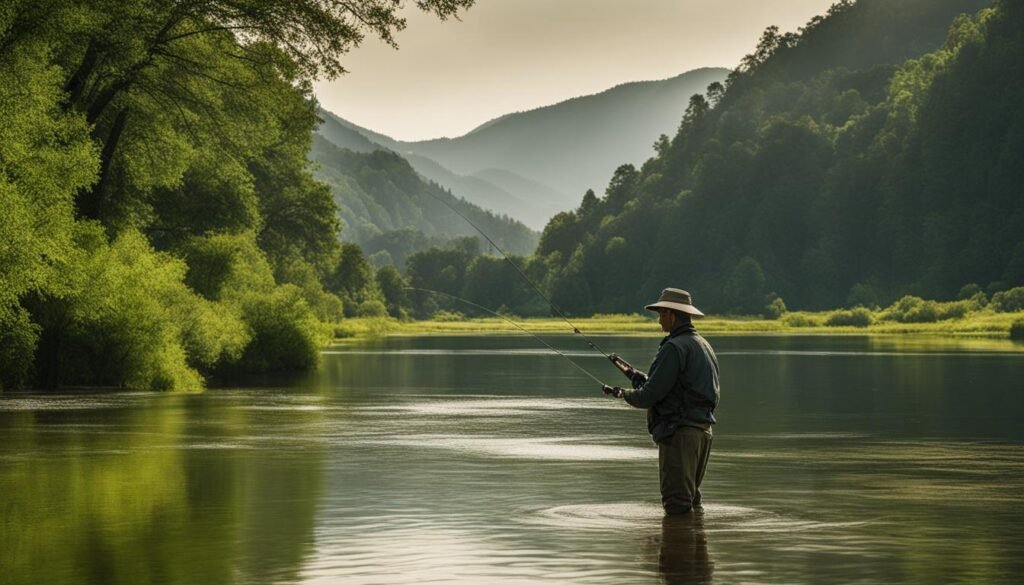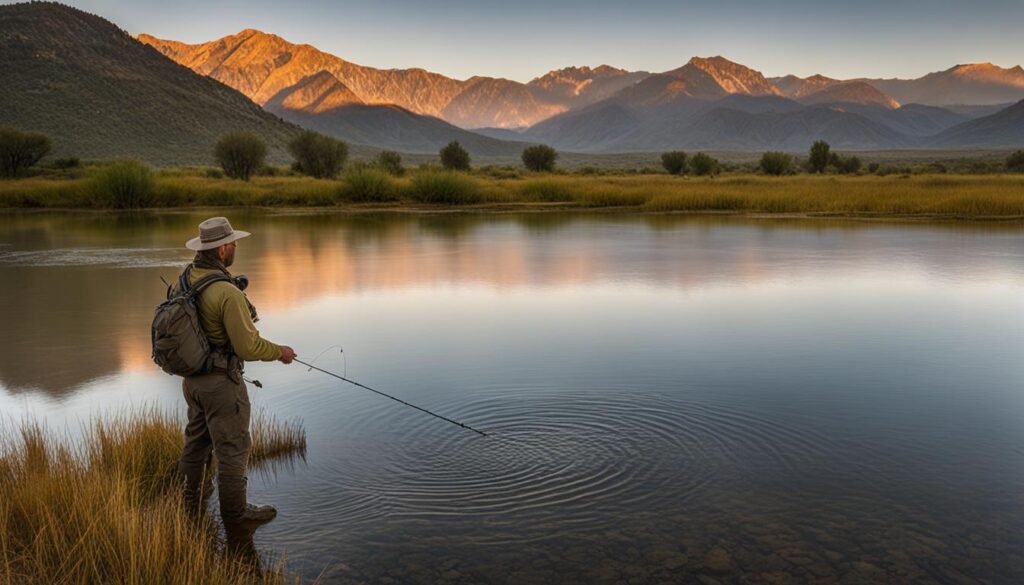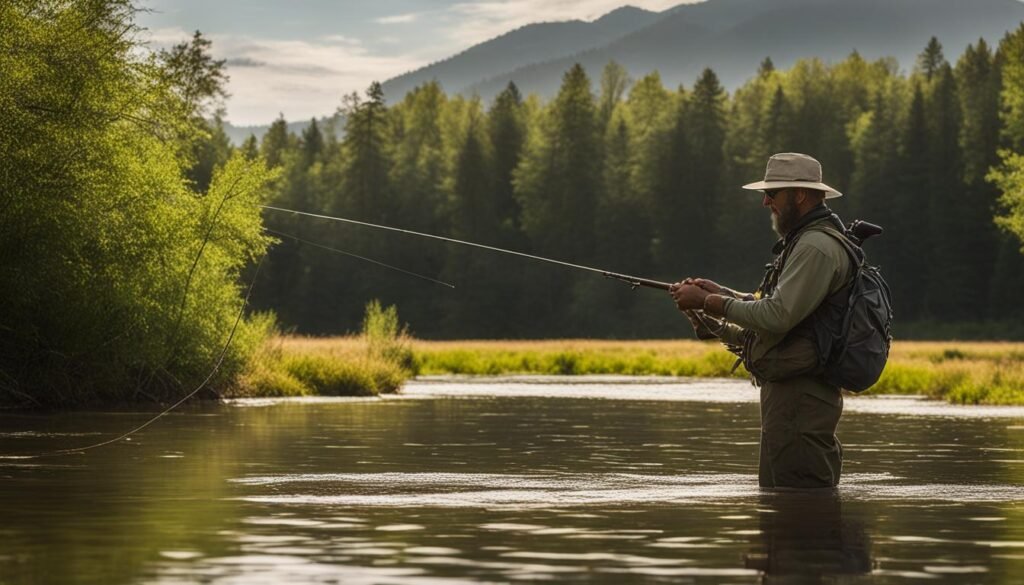Dry fly fishing is considered the pinnacle of the sport, and this ultimate guide will provide you with everything you need to know to master this technique. Whether you’re a beginner or an experienced angler, these dry fly fishing tips will help you elevate your fishing experience. One key aspect of dry fly fishing is learning to match the hatch, which means selecting flies that mimic the size and silhouette of the insects that are actively emerging on the water.
Key Takeaways:
- Dry fly fishing is a highly sought-after technique that requires skill and practice.
- Matching the hatch by selecting flies that resemble the insects on the water’s surface is essential for success.
- These dry fly fishing tips are applicable to both beginners and experienced anglers.
- Understanding proper fly pattern presentation and reducing drag on your flies can increase your chances of enticing trout.
- Mending techniques, such as aerial mends and on-water mends, help achieve a drag-free drift.
The Importance of Fly Pattern Presentation
When it comes to dry fly fishing, the presentation of your fly pattern is just as important as the pattern itself. Whether you’re using a meticulously tied imitation or a simple attractor pattern, how you present it on the water can make all the difference in enticing trout to take your fly. Many anglers focus solely on selecting the perfect fly pattern, but neglecting the presentation can lead to missed opportunities.
To maximize your chances of success, it’s crucial to reduce drag on your flies and ensure a natural drift. Drag occurs when the current pulls your fly and tippet in different directions, making it appear unnatural to the fish. By minimizing drag, you can create a more convincing presentation that mimics the behavior of real insects on the water’s surface.
There are several techniques you can employ to reduce drag and improve your fly pattern presentation. One important technique is to mend your fly line, which involves repositioning your line on the water to eliminate drag. Aerial mends can be made while your line is still in the air, and on-water mends can be performed once your line has landed on the water. These mending techniques allow you to adjust the position and speed of your fly, ensuring a drag-free drift and increasing your chances of enticing trout to strike.
Fly Pattern Presentation Tips
- Cast your fly upstream of the target area, allowing it to drift naturally towards the fish.
- Avoid excessive false casting, as it can spook fish and increase the chances of drag on your line.
- Use reach casts and curve casts to position your fly in a way that reduces drag and extends your drift.
- Observe the behavior of rising fish to determine the speed and direction of your presentation.
- Experiment with different line mending techniques to achieve the most natural drift possible.
Remember, successful dry fly fishing requires both the right fly pattern selection and proper presentation techniques. By reducing drag on your flies and ensuring a convincing drift, you can increase your chances of fooling even the most selective trout. So next time you’re on the water, pay close attention to your fly pattern presentation and watch as the fish rise to your perfectly presented flies.
| Fly Pattern Presentation Techniques | Description |
|---|---|
| Aerial mends | Performed while your fly line is still in the air, adjusting the position of your line to reduce drag. |
| On-water mends | Performed once your line has landed on the water, repositioning your line to achieve a drag-free drift. |
| Reach cast | A cast that allows you to place your fly downstream of the tippet, extending your drag-free drift. |
| Curve cast | A cast that helps you avoid lining the fish and can be useful when casting around obstacles. |
Proper Mending Techniques for Drag-Free Drifts

Mending is a crucial skill to master for successful dry fly fishing. It allows you to counteract drag and achieve a drag-free drift, increasing your chances of enticing trout to take your fly. There are two main types of mending techniques: aerial mends and on-water mends.
Aerial mends are performed while your fly line is still in the air and are particularly important for dry fly fishing. They involve manipulating the line’s trajectory to ensure a natural drift. One effective aerial mend technique is the reach cast. This cast allows you to place the fly downstream of the tippet, extending the drag-free drift and enticing trout that may be positioned further downstream. Another useful cast is the curve cast, which helps you avoid lining the fish and allows for precise presentations around obstacles.
On-water mends, as the name suggests, are performed when your line has already landed on the water’s surface. They involve using various techniques to manipulate the current and achieve a drag-free drift. These mends can be achieved by flicking your rod tip or utilizing roll casts to reposition the line and fly without disturbing the water’s surface.
Aerial Mends: Reach Cast
| Technique | Description |
|---|---|
| Reach Cast | Place the fly downstream of the tippet for a longer drag-free drift |
| Curve Cast | Helps you avoid lining the fish and useful when casting around obstacles |
Selecting the Right Dry Flies
Choosing the right dry flies is crucial for successful dry fly fishing. To increase your chances of attracting feeding trout, you need to consider the size, silhouette, and color of the flies to match the hatch. Dry flies come in a variety of patterns, including caddis flies, mayflies, stoneflies, and terrestrial insects. Having a selection of different dry fly patterns in your fly box is essential for adapting to various fishing conditions.
Dry Fly Selection
When selecting dry flies, it’s important to observe the insects that are actively emerging on the water. Look for any noticeable patterns or specific insects that trout are feeding on. This will give you a better idea of what fly patterns to choose. Additionally, consider the size and silhouette of the insects. Matching the size of the flies to the natural insects can greatly improve your chances of success.
Best Dry Fly Patterns
Some popular dry fly patterns that have proven effective in different fishing situations include Elk Hair Caddis, Adams, Royal Wulff, Stimulator, and Parachute Adams. These patterns mimic various insects and are versatile options that can be used in different water conditions. It’s also a good idea to have a range of sizes for each pattern to accommodate different hatch sizes.
Experimentation and observation are key when selecting dry flies. Pay attention to how the fish are responding to different patterns and adjust accordingly. By having a well-stocked fly box with a variety of dry flies, you’ll be prepared to meet the demands of different fishing scenarios and increase your chances of success on the water.
| Fly Pattern | Targeted Insect | Best Fishing Conditions |
|---|---|---|
| Elk Hair Caddis | Caddisflies | Fast-moving water, pocket water |
| Adams | Mayflies | Slow-moving water, calm conditions |
| Royal Wulff | Various insects | All-around pattern, versatile |
| Stimulator | Stoneflies, grasshoppers | Terrestrial fishing, pocket water |
| Parachute Adams | Mayflies | All-around pattern, calm conditions |
Gear and Equipment for Dry Fly Fishing
When it comes to dry fly fishing, having the right gear and equipment is essential for a successful outing. Here are some important items you should consider:
Fly Rod Selection
Choosing the right fly rod is crucial for dry fly fishing. A lightweight fly rod in the 4-6 weight range is typically suitable for this technique. This weight range provides the necessary sensitivity and flexibility to cast delicate dry flies accurately.
Dry Fly Dressing
Dry fly dressing is a key element in ensuring your flies float well on the water’s surface. Applying a high-quality floatant to your dry flies before casting will help keep them buoyant and visible to unsuspecting trout.
Leaders and Tippet
Long leaders and thin tippets are necessary for effectively presenting dry flies. A long leader allows for a more delicate presentation, while a thin tippet helps fool wary trout. Opt for leaders and tippets with low visibility and high knot strength to ensure successful hookups.
| Item | Recommendation |
|---|---|
| Fly Rod | 4-6 weight range |
| Dry Fly Dressing | High-quality floatant |
| Leaders and Tippet | Long leaders, thin tippets |
By selecting the right gear and equipment for dry fly fishing, you’ll be well-prepared to tackle any fishing situation. Remember to choose a suitable fly rod, apply dry fly dressing for floatation, and use appropriate leaders and tippets for fooling trout. With the right gear in hand, you’ll be ready to enjoy the thrill of dry fly fishing and increase your chances of success on the water.
Observing and Understanding the Water

To successfully fish with dry flies, it’s important to observe and understand the water. This involves keenly watching for rising fish and identifying the specific insects they are feeding on. By developing situational awareness and staying attuned to the current insect hatches and fish behavior, you can strategically present your dry flies to increase your chances of success.
Observing rising fish is a key aspect of dry fly fishing. Look for telltale signs such as subtle rises, swirls, or the occasional splash on the water’s surface. Take note of the frequency and location of these rises, as this can give you valuable insight into the feeding patterns of the fish. Additionally, observe the behavior of the fish to understand their preferences. Are they actively cruising the surface or selectively targeting insects in specific areas? Paying attention to these details will allow you to make informed decisions when selecting your dry fly patterns.
Understanding insect hatches is another crucial element of successful dry fly fishing. Different types of insects hatch throughout the year, and being aware of these hatches will help you select the appropriate flies to match what the fish are naturally feeding on. Keep an eye out for any visible signs of insects, such as mayflies or caddisflies fluttering above the water, or the presence of shucks floating downstream. By identifying the specific insects that are active on the water, you can choose flies that closely mimic their size, color, and behavior, making your presentation more enticing to the fish.
Positioning and Stealth in Dry Fly Fishing

When it comes to positioning for dry fly fishing, it’s important to consider the current and structure of the water. Look for areas where trout are likely to feed, such as riffles, seams, and eddies. Position yourself in a way that allows for accurate and delicate presentations, taking advantage of natural cover like rocks or vegetation. By being in the right place at the right time, you can effectively present your dry flies to actively feeding fish.
Stealth is another key component of dry fly fishing. Trout are sensitive to disturbances in the water and can be easily spooked. To avoid alerting the fish, move slowly and quietly along the bank or in the water. Wear natural-toned clothing that blends in with the environment and minimize your shadow and silhouette. By practicing stealth, you can enhance your ability to get close to fish without alarming them.
Wade Fishing Techniques
Wade fishing is a popular method for dry fly fishing, as it allows anglers to access areas that are inaccessible by boat. When wading, it’s important to move cautiously and use proper techniques to avoid disturbing fish and maintain your balance.
- Move slowly and plant your feet firmly in the water to minimize vibrations.
- Use a side-to-side shuffle rather than lifting your feet off the bottom to reduce splashing and disturbance.
- Take advantage of natural currents and eddies to assist with your movement and casting.
- Keep your rod low and pointed downstream to prevent the line from dragging on the water’s surface.
By mastering these wade fishing techniques, you can effectively navigate the water, maintain your stealth, and increase your success with dry fly fishing.
| Positioning | Stealth | Wade Fishing Techniques |
|---|---|---|
| Find areas where trout are likely to feed | Move slowly and wear natural-toned clothing | Move cautiously and use a side-to-side shuffle |
| Position yourself for accurate presentations | Minimize your shadow and silhouette | Plant your feet firmly and avoid lifting them off the bottom |
| Utilize natural cover for stealthy approaches | Reduce splashing and disturbance | Take advantage of natural currents and eddies |
FAQ
What is dry fly fishing?
Dry fly fishing is a technique where anglers use flies that float on the water’s surface to imitate insects and entice fish to strike.
How do I match the hatch for dry fly fishing?
Matching the hatch involves selecting flies that mimic the size and silhouette of the insects that are actively emerging on the water.
Is fly pattern presentation important in dry fly fishing?
Yes, the presentation of the fly is just as important as the fly pattern itself. By reducing drag and ensuring a natural drift, you can increase your chances of attracting fish.
What are some mending techniques for dry fly fishing?
Aerial mends and on-water mends are two types of mend techniques. Aerial mends involve adjusting your fly line while it’s still in the air, and on-water mends are performed after the fly lands on the water. These techniques help counteract drag and achieve a drag-free drift.
How do I choose the right dry flies?
When selecting dry flies, consider the size, silhouette, and color to match the hatch and attract feeding fish. Having a variety of patterns, including caddis flies, mayflies, stoneflies, and terrestrial insects, in your fly box is important for adapting to different fishing conditions.
What gear and equipment do I need for dry fly fishing?
For dry fly fishing, a lightweight fly rod in the 4-6 weight range is typically suitable. Using dry fly dressing on your flies can help them float better, and long leaders and thin tippets are necessary for fooling wary fish.
How can I observe and understand the water for dry fly fishing?
Observing for rising fish and identifying the insects they are feeding on can help you strategically present your dry flies. By being aware of current insect hatches and fish behavior, you can increase your chances of success.
What is the importance of positioning and stealth in dry fly fishing?
Proper positioning in casting spots and minimizing disturbance in the water are critical for effective dry fly fishing. Moving slowly and wearing natural-toned clothing can help you blend in with the environment and avoid spooking fish.
How can I enhance my dry fly fishing skills?
By following the tips outlined in this guide, such as considering fly pattern presentation, proper mending techniques, fly selection, gear and equipment, observing the water, positioning, and stealth, you can enhance your dry fly fishing experience and increase your chances of success.

